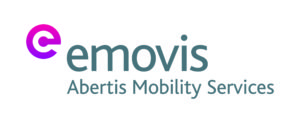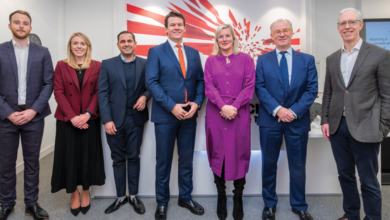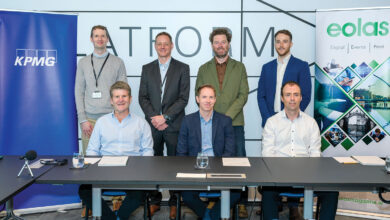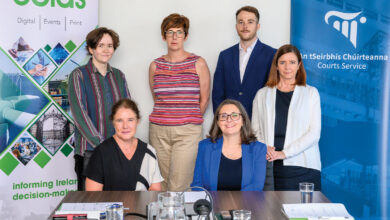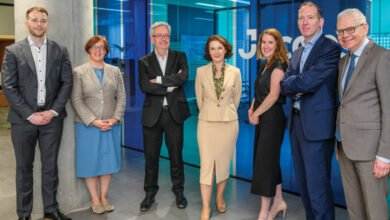Digital innovation in transport
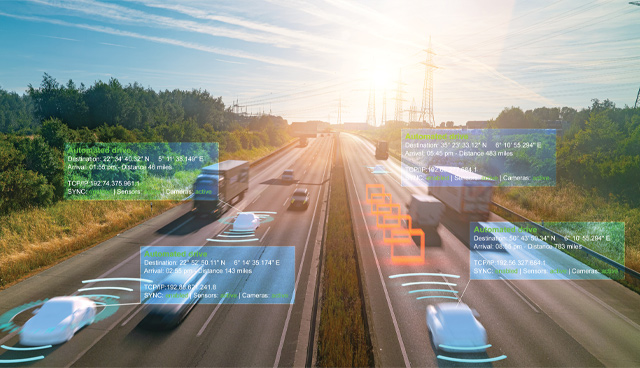
emovis hosted a virtual round table discussion with key stakeholders from across the transport sector, utilising their expertise to explore the potential for digital innovation in transport and mobility in Ireland.
What are the biggest challenges facing digital innovation and transformation in the transport and mobility sector?
Stephen McCarthy
The need to break down silos. Transportation has evolved but many of the problems have been solved in isolation and what we’re seeking to do through digital innovation is to create an environment of collaboration between the various transport stakeholders. Another challenge is around privacy and ensuring that, as more information is gathered and shared, data doesn’t become a problem in how it is being used.
Rachel Cahill
Digital transformation is a huge area and covers everything from electric vehicles, to smart motorways and even how we pay for things. The biggest challenge is keeping up with the pace of change. Innovation and transformation is driven by changes in societal behaviours and there is a need to remain cognisant of these. In the context of transport and mobility, designing public transport infrastructure and systems for future users in an ever-changing environment is the biggest challenge.
Alan Murphy
For administrators and policy makers, it’s about allowing them the freedom to reimagine the possible. It’s never really about the technology. When it comes to technology-enabled transformation, the technology will generally do what it is designed to do. It’s more about the mindset and the appetite for change amongst key stakeholders. On the user (passenger) side, it’s also about challenging the current mindset. Getting away from a dependency on the car will require solutions to help users think differently about their travel choices.
Bernard Higgins
We’re in a time of unprecedented uncertainty in terms of how people use public and private transport. Whether or not journey patterns will return to how they were pre-Covid-19 remains to be seen. We need to support shifting travel patterns with digital innovation. In designing and implementing for future platforms, we really need to be cognisant of these changing behaviours.
Bidisha Ghosh
We need to have a knowledge of global innovation. Transportation 5.0 is a new concept relating to the digitisation of transportation across the world. It’s something we need to remain conscious of and explore what we can implement in Ireland. In order to do this, we need to appraise our existing local resources and identify what can be utilised to effectively advance the cause. Additionally, we need to be aware that Transportation 5.0 didn’t consider Covid-19. We now need to think about how to integrate that for decarbonisation, public transport and sustainable transport in the era of digitised innovation.
Digital can allow for greater integration between transport and mobility providers, both private and public. Do you see this happening in Ireland?
Alan Murphy
Yes, there are significant signals within the latest Programme for Government, which indicate a willingness for modal shift, demand management, e-scooter regulation and embracing more sustainable transport. Those signals will trickle down to mobility operators, local government, the NTA, etc. It’s a great example of executive sponsorship from government. Simultaneously, we can take huge confidence from the experience of digital innovation in other domains. For example, the move to online banking and ecommerce has been transformative and was perhaps unimaginable 20 years ago.
Bernard Higgins
I think it is possible though not a given. There are a huge number of challenges that must be addressed to make such an investment viable. We must be careful to ensure that the customer is front and centre in our thinking. Given the potential cost of integration, we need to be clear as to how the travelling public will reap the benefit of that investment in terms of time and money saved. We need to understand our market, what volume of people will adopt these solutions and the extent to which our innovation will convince people to leave their cars at home. In addition, we need to put in place the governance and regulatory frameworks required to facilitate technology integration between public and private transport providers.
Bidisha Ghosh
Ireland is poised to be at the forefront of European countries in making this happen. The EU has adopted the Digital Single Market strategy which requires many improvements in the transport sector including our logistics and freight to move into the digital sphere. In other words, the EU is advocating the digitalisation of transport. Ireland does not necessarily need to innovate solutions; solutions will be innovated elsewhere in Europe and can then be implemented in Ireland. Transportation 5.0 is essentially society-driven transportation. It’s not about how we invest in new technologies for digitisation, it’s about utilising what already exists. Through crowdsourcing and social behaviour analysis, we can create a closed loop or what is referred to as the parallelisation of transportation. Working together, while being GDPR compliant, we can create an integrated platform where scalability and synchronisation are addressed.
Women make up 50 per cent of the population but their distinct travel needs are not well understood and because of that do not feed in to transport policy and design.
— Rachel Cahill, Head of Financial Management, Transport Infrastructure Ireland
Rachel Cahill
Yes, I do see it happening in Ireland, but I think we have a long way to go. From a public sector and Government perspective, we need to step up and be at the forefront of common platforms, open data and big data initiatives. Likewise, we need to be more innovative and adopt a private sector or an entrepreneurial mindset. If we don’t assume a leadership role, we could be left behind, blind to developments around us.
Stephen McCarthy
I am very optimistic about what’s ahead. Reflecting on how far we’ve already come, perhaps we take a lot for granted. I think back to the days when I was growing up in Clontarf and heading into town on the number 30 bus with my mam and then I compare that with the bus journeys that my kids make; they’re completely different experiences. Today, those journeys are infused with digitalisation and connectivity. Extrapolating that into the future, the possibilities are endless. Everything will be connected, and the data will be there; it’s just a matter of whether we can harness and utilise it in a safe way.
What, if any, are the possible negative impacts of digital innovation on the end user (customer), are there any cohorts that digital might leave behind and how do we address this?
Bernard Higgins
There are several risks associated with integration and we need to be in tune with all of our customer’s needs. Certain innovations will prove popular, for example, access to real time passenger information (RTPI) on smart phones. That being said, we still get a lot of requests for timetable posters at bus stops. There are people who don’t have bank accounts or internet access or who may have higher support needs and find it difficult to engage with complex technology solutions. Particularly from a public transport perspective, we must always be inclusive in our thinking when designing and implementing solutions.
I would like to see one platform where all the transportation players in this country, be they public, private, come together along with the general public.
— Bidisha Ghosh, Chair of Irish Transport Research Network (ITRN) and Assistant Professor at Trinity College Dublin
Bidisha Ghosh
Research has highlighted a digital divide in the population and the European Council recognises this. It’s the rationale behind a number calls for projects looking to address firstly, the needs of people who are not able to engage with digital transport and secondly, from a ‘Human Factors’ perspective, how to develop user-friendly digital platforms. So, if you have an app, how can that app be ergonomically designed to make it accessible and easy to use for the whole population? Another element of this is called the technology acceptance model, which is used to find out what the acceptance rate is of certain technologies. I think Ireland has an ample opportunity to do this. Taking RTPI as an example, what is the acceptance rate of that technology and how can this be improved across different socio-economic demographics? This is an area ripe for research and application.
Stephen McCarthy
To ensure that people are not disenfranchised, there is a need to focus on the experience of the end-user. In my previous role in telecoms we came across the same issues. We know the reason that certain apps are more popular is because they are compelling, simple and easy. However, ‘simple’ is not necessarily ‘easy’. To really understand what people want and how they will interact is difficult and I think there’s an acceptance that solutions are rarely right first time. However, constant tweaks, improvements and building can lead to compelling solutions. Another focus is ensuring we don’t amplify the existing rural/urban divide. A lot of the focus of digital transport has been in urban areas around issues such as congestion or shared infrastructure and we must ensure we are achieving a more sustainable balance rather than exacerbating that divide.
When it comes to the integration of public and private mobility operators and the digital innovation required to make this happen, I think there is a need for public sector-led oversight.
— Alan Murphy, Smart Dublin Regional Manager, Smart Dublin
Alan Murphy
In the smart city arena, we are seeing new technology coming at cities in waves. There is an option to do nothing but that comes at a risk that technology gets deployed in an uncontrolled way with potential for unintended consequences. When it comes to the integration of public and private mobility operators and the digital innovation required to make this happen, I think there is a need for public sector-led oversight. Firstly, because we want to make sure that these initiatives deliver against expected benefits to society. Secondly, it acknowledges that user cohorts are not homogenous. There are certain cohorts that may not embrace this kind of digital innovation, so we need to make sure they don’t get left behind. Thirdly, to integrate public and private mobility operations, there’s a requirement for trust amongst the stakeholders. A public-led initiative gives reassurance that this is an ‘Ireland Inc.’ initiative. That’s the feedback we’ve had from some of the mobility operators in Dublin.
Rachel Cahill
The traditional methods of collecting transport data do not reflect the needs and behaviours of all users. As a result any digital innovation in this space may leave some people behind. For example, the needs of those with mobility challenges like the elderly, women, people with disabilities and people travelling with children or dependants, are not adequately captured by traditional data collection methods. Looking at women specifically, it is internationally recognised that women and men have different mobility patterns, with women’s being more complex due to trip chaining and caregiving roles. Women make up 50 per cent of the population but their distinct travel needs are not well understood and because of that do not feed in to transport policy and design. Filling this gender data gap is the first step in balancing traditional bias in the design of future transport solutions.
Digitally driven transport and mobility solutions harvest information to inform future strategies, do you see an issue with certain organisations having too much information on the end user?
Stephen McCarthy
It’s all about data really. Each of us creates a multitude of data as does the public transport network. In order to make the future of mobility work, we must create connections between different pools of data. We can then utilise this data to understand how people are using existing infrastructure, enabling us to ensure that the infrastructure is as effective and as efficient as it can be. Is there possibility for domination? That is a real risk. The big tech companies dominate the digital world currently. There is a genuine and growing concern about the information that is available to them and how they use this to drive revenue. The same is true in transportation. One risk is that private operators might gravitate towards profitably in the first instance.
Given the potential cost of integration, we need to be clear as to how the travelling public will reap the benefit of that investment in terms of time and money saved.
— Bernard Higgins, Director of Transport Technology, National Transport Authority
Bernard Higgins
We generate vast volumes of data and the challenge for us is to convert that into useful information. We already have a business intelligence unit in place and have used it extensively throughout the Covid-19 pandemic to understand emerging travel patterns. However, the crux of the question relates to personal data. We are bound by strict regulation in terms of the retention and protection of that data. There are organisations within the private sector which probably see great potential value in having access to that data. As such, the development of regulatory structures and frameworks will ensure that data is handled appropriately. In terms of the integration agenda, this is highly significant.
Alan Murphy
If there is an integrated target operating model, between public and private mobility operators, the type of data made available to each of the stakeholders must be proportionate to their role in that model or value chain. Public-led oversight will be key to ensuring that this architecture considers data protection, what data is shared and what data is required for the next link in the chain to operate efficiently. That oversight can manifest itself in different ways. For example, within the councils, we licence mobility operators such as bicycle or car sharing schemes. We are now examining the licence structures of those operators with a view to collaborate more on the data they generate to better understand the effectiveness of such schemes.
Bidisha Ghosh
Information is constantly being created in the transport and mobility space by different enterprises. We need to collate that data under a single archival umbrella, which I’m calling ‘the transport research centre’. In the context of a proliferation of data, there is a need to create value-added information. In raw form, the data may not be of any use to the parties involved in an integration platform. It is also immensely important to note that the collected data is in different formats, different levels ranging from micro to macro, different scales. Within these, stakeholders with permission can pinpoint relevant data. Links from one layer to the next enable navigation within this intricate space and the creation of optimally valuable information. We also need to invest in human resources; people who are experts and can use the data to create a cohesive space.
Rachel Cahill
It’s about capturing data, what we do with it and what it tells us. The world will not work the way we want it to without data and data sharing, but people’s personal data must be protected and respected. We all acknowledge that. We are fortunate that GDPR enables us to do what we require while simultaneously protecting individuals’ data. It challenges us to be more innovative perhaps, but it’s something we should be proud of.
If there was one thing you could change immediately (if there were no restrictions) with regards to digital innovation in transport and mobility, what would it be and why?
Stephen McCarthy
I’d like to multiply the amount of people who are championing the cause of digital innovation in transport. People, alongside leadership and vision, enable change and so I would like an amplification of the current debate.
Each of us creates a multitude of data as does the public transport network. In order to make the future of mobility work, we must create connections between different pools of data.
— Stephen McCarthy, Chief Executive Officer, Emovis Ireland
Bidisha Ghosh
I would like to see one platform where all the transportation players in this country, be they public, private, come together along with the general public. Primarily, it would facilitate the integration of all available data, models as well as explore different objectives of different stakeholders. Once this integrated platform is created, we can then further understand what information is required and also identify common goals and objectives. That’s an initial step. Once complete, we can then look into more innovative goals, such as becoming a global leader in advanced digital transport and mobility.
Alan Murphy
The change of user (passenger) mindset and a shift away from cars is a major challenge, so I believe we need mechanisms (e.g. from central government) which encourage and reward users for choosing sustainable modes of transport. There are precedents, such as the cycle to work scheme. An amplification of those incentive models, learning from other countries, would really help nudge user behaviour. On a separate note, I’d like to see a move for Dublin and other urban centres in Ireland to the 15-minute city concept, where we re-imagine cities so that people don’t have to move around extensively in the first place.
Rachel Cahill
I would like to see government, at a national and local level, be more at the forefront of digital innovation and be more open minded. Incentivising the modal shift and sustainability is innovative, but it needs to be driven by government. I would like to see that broadened out to capture things like collaboration and interagency communication to create platforms. By this, I don’t mean digital platforms, I mean people platforms. People connecting with people makes things happen and so it’s about creating the conditions for people to drive change.
Bernard Higgins
We have a lot of skilled and talented people working on solutions that will deliver solid building blocks for potential future integration platforms. Next Generation Ticketing (NGT), Automatic Vehicle Location (AVL) and new RTPI solutions are prime examples and to be fair, Government is providing us with the required resources to deliver these solutions. If I had a magic wand, I’d accelerate the development and adoption of data and technology standards. It’s a big challenge in the technology sphere and it has the potential to accelerate the delivery of our technology programmes in the years ahead.
Round table participants
Rachel Cahill
Rachel is Head of Financial Management and Sustainable Mobility Lead with Transport Infrastructure Ireland (TII). She is leading TII’s Sustainable Mobility Initiative and is the business owner and sponsor of TII’s recent Travelling in a Woman’s Shoes study and report. Rachel is a chartered accountant and is responsible for the financial control and governance of TII’s commercial operations. Rachel has over 20 years’ experience working in complex and demanding financial and operational environments including the last 14 years working in the transport and mobility sector. Prior to joining TII, Rachel spent 10 years working in the banking industry in both operational and financial roles.
Bidisha Ghosh
Bidisha is an Assistant Professor in the School of Engineering at Trinity College Dublin. She is the chair of the Irish Transport Research Network, the national body for transportation research in Ireland. She has published over 100 peer-reviewed conference and journal papers and is an associate editor of IET Intelligent Transport Systems, a member of the editorial board of Transportation Research Part C, IEEE Smart Cities Smart Mobility Committee. Bidisha has been a PI in multiple national and EU projects in the field of traffic and transportation modelling, environmental modelling and infrastructure management.
Bernard Higgins
Bernard is Director of Transport Technology with the National Transport Authority (NTA). He has an engineering, procurement and ICT background in the public and private sectors. He is responsible for setting the strategic direction and leading the development and delivery of best-in-class technology solutions for all public transport in the State that the NTA has responsibility for.
Stephen McCarthy
Stephen is responsible for overseeing emovis’ operations in Ireland where it provides innovative solutions in the area of transport and mobility to clients. Previously, he was the Head of Transition Management in emovis, with responsibility for transitioning new mobility solutions to Ireland from the company’s international markets. Prior to joining emovis, Stephen worked for Vodafone for 16 years, and held the positions of Head of Quality and Performance Improvement and Change and Transformation Programme Manager for the multinational company. Earlier in his career he was an IT solutions architect and consultant for both Vertel and Astracon, and worked across their offices in Dublin, New Jersey, and Chicago.
Alan Murphy
Alan is the Smart Dublin Regional Manager working across all four Dublin local authorities, exploring emerging technology to provide better public services. He has extensive experience in developing new business models and delivering change via technology projects in the energy, healthcare, pharmaceuticals, consumer goods, manufacturing and humanitarian sectors. Alan was the Design Authority on the Irish Smart Metering programme which sparked his interest in Smart Cities. He has previously worked for PwC, IBM and HCL Axon amongst others. Alan’s qualifications include a business studies degree and postgraduate diploma in computing from the University of Limerick.
